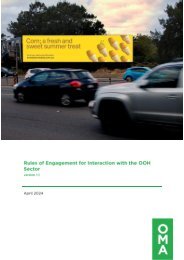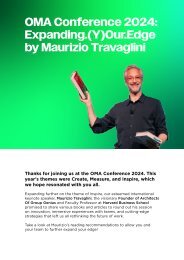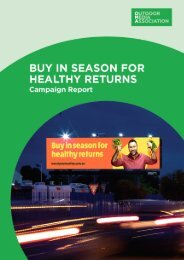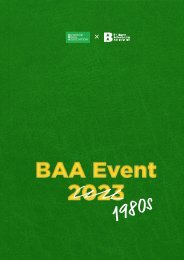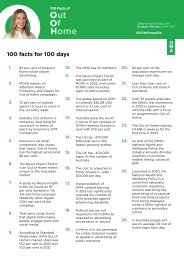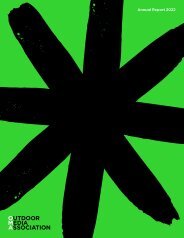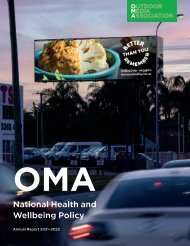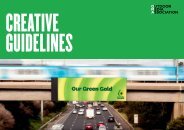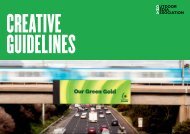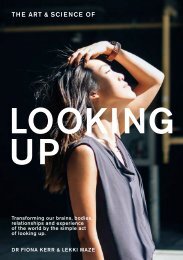OPEN 2
The OPEN series was born from the desire to create a forum for applauding and interrogating strong creative design within the Out of Home (OOH) industry. Illustrating how OOH is part of our cityscape, our commute, our weekend and our shopping and holiday experiences, OOH is ‘the original tweet’ and it cannot be switched off, ignored or fast forwarded. Big, bold, cheeky, simple, clever and controversial, OOH is the ultimate creative stage, allowing brands to be unique, contextually relevant and targeted while reaching mass audiences.
The OPEN series was born from the desire to create a forum for applauding and interrogating strong creative design within the Out of Home (OOH) industry. Illustrating how OOH is part of our cityscape, our commute, our weekend and our shopping and holiday experiences, OOH is ‘the original tweet’ and it cannot be switched off, ignored or fast forwarded. Big, bold, cheeky, simple, clever and controversial, OOH is the ultimate creative stage, allowing brands to be unique, contextually relevant and targeted while reaching mass audiences.
Create successful ePaper yourself
Turn your PDF publications into a flip-book with our unique Google optimized e-Paper software.
INTRODUCTION<br />
Charmaine Moldrich, Chief Executive Officer,<br />
Outdoor Media Association<br />
...<br />
When we published the first edition of <strong>OPEN</strong><br />
in 2012 the Out-of-Home (OOH) industry was<br />
tentatively dipping its toes into technologies<br />
such as Near Field Communication (NFC),<br />
facial recognition and consumer engagement<br />
using SMS, WiFi and GPS. The content for<br />
<strong>OPEN</strong> was predominantly selected with an<br />
artistic eye, rewarding the simple, the bold<br />
and, of course, the cheeky. In <strong>OPEN</strong>² the<br />
examples we’ve chosen of some of the best<br />
OOH from around the world represent how<br />
far the industry has evolved in just two years.<br />
At the 2014 Cannes Lions International<br />
Festival of Creativity, I was struck by how OOH<br />
is increasingly becoming reflective of culture<br />
and society. ANZ Bank’s GAYTMs campaign<br />
(p. 127) was not only a unique and creative<br />
promotion, it was also a contextually relevant<br />
social statement in support of the annual<br />
Sydney Gay and Lesbian Mardi Gras – not<br />
surprising that it took out the Grand Prix award<br />
for Outdoor.<br />
An unprecedented 5,600 entries for the<br />
OOH category were submitted to Cannes Lions<br />
in 2014, more than for any other category. This<br />
proves that OOH has well and truly arrived and<br />
creatives are excited about the potential of this<br />
‘ultimate creative stage.’<br />
<strong>OPEN</strong>² shows us not only how far we’ve<br />
come, it also hints at where we’re headed.<br />
It demonstrates a respect for the traditional,<br />
an eagerness for innovation, and an<br />
ongoing commitment to clear and effective<br />
communication – which is still what our<br />
industry is all about.<br />
Sir John Hegarty put it this way, “Selling<br />
stuff has never been a science. It’s all about<br />
persuasion.” And I would add to that, ‘emotion.’<br />
If you can make someone feel something,<br />
they are more likely to do something. Hegarty<br />
also noted that, “a brand is made not just by the<br />
people who buy it, but also by the people who<br />
know about it.” It is the combination of these<br />
two ideas that makes OOH so potent. It has<br />
the power to inspire (and persuade) and it is<br />
ubiquitous. Put simply: it gets the word out.<br />
In <strong>OPEN</strong>² we have divided OOH’s<br />
persuasion into four sections: Humour Me,<br />
Sell Me Something, Tell Me a Story and<br />
Interact with Me. Industry leaders were<br />
asked to provide insight into these sections<br />
– how the challenges of advertising have<br />
moulded careers, affected lives and ultimately<br />
changed perspectives. We are grateful<br />
for our contributors’ time and thoughtful<br />
consideration of the task. The results are truly<br />
inspiring.<br />
Dedicating a section to humour was<br />
an obvious choice for an industry that doesn’t<br />
take itself too seriously. In Humour Me, Jane<br />
Caro, writer, lecturer and media commentator,<br />
muses on the value of ‘shocking’ audiences<br />
and how similar we are in our reactions.<br />
Fiona Jolly, CEO of the Advertising Standards<br />
Bureau, writes about the important role of<br />
OOH regulation and how humour can be used<br />
to assuage conservative opinions. Nigel Marsh,<br />
author and Chairman of The Leading Edge,<br />
reminisces about his early days in advertising<br />
and the seminal campaigns that helped<br />
to shape his view of the world.<br />
In Sell Me Something, Ben Colman, CEO<br />
of 18 Feet & Rising, delves into the pop-culture<br />
history of advertising and explores the value<br />
of truth. Ben Coulson, CCO of GPY&R Australia<br />
and New Zealand, contemplates the dark art<br />
of selling juxtaposed with the reality of<br />
consumer desire.<br />
For Tell Me a Story, Andy Lark, former<br />
CMO of the Commonwealth Bank of Australia<br />
and now CEO of Group Lark, writes eloquently<br />
about the power of OOH and the factors that<br />
will make it even more crucial in the years<br />
ahead. Ben Welsh, Executive Creative Director<br />
at M&C Saatchi, tells of his experience judging<br />
the Cannes Lions and notes that OOH is now<br />
part of our culture, each country uniquely<br />
represented through its advertising. Rob<br />
Atkinson, CEO of Adshel, rounds out this<br />
section, sharing his experiences and excitement<br />
of working in OOH, “for more years than I care<br />
to mention,” witnessing the sudden arrival of<br />
huge change and opportunity.<br />
The contributors for Interact with Me<br />
write about the break-through campaigns that<br />
are inspiring younger generations, such as<br />
Coca-Cola’s Small world machines campaign<br />
(pp. 156–157). Luke Chess, Creative Director,<br />
MJW Australia, encourages advertisers<br />
and marketers to strive for “meaningful<br />
interaction” in all campaigns. John Purcell,<br />
Commercial Director, Operations & Business<br />
Systems for oOh! Media, highlights the value of<br />
OOH technologies – particularly for technology<br />
companies – and how these partnerships<br />
will benefit consumers. Leo Roberts, Group<br />
Marketing Manager, Integrated Marketing<br />
Communications, Coca-Cola South Pacific,<br />
notes that interactive technologies not only<br />
engage the consumer, but also excite the<br />
advertiser, providing new platforms for brands.<br />
We have collected a diverse range<br />
of campaigns, from billboards that purify the<br />
air to a series of McDonald’s advertisements<br />
(pp. 68–69) that demonstrate how a brand can<br />
capitalise on its history. The executions come<br />
from around the world, featuring brands you<br />
know and love and some you may have never<br />
heard of.<br />
What these campaigns have in common<br />
is that they have all been part of a cityscape,<br />
of someone’s commute, of their weekend, their<br />
shopping or holiday experience; they were all<br />
part of people’s everyday lives. That’s OOH.<br />
We present <strong>OPEN</strong>² to you for your<br />
consideration, entertainment and inspiration.<br />
5 /



